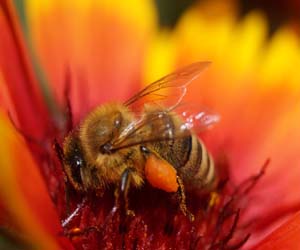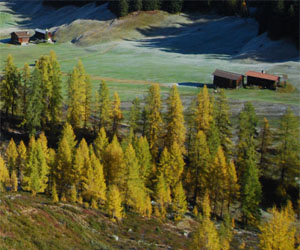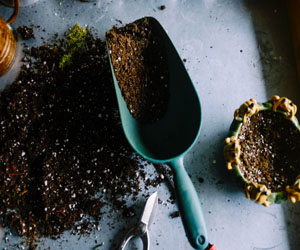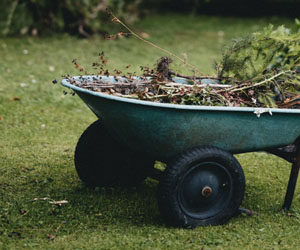


Gardening For Wildlife

Gardens are not just for human enjoyment; they can also serve as sanctuaries for wildlife. Gardening for wildlife is a practice that harmoniously coexists with nature, welcoming birds, insects, and small mammals into your outdoor space. In this article, we'll explore the benefits of gardening for wildlife and provide tips for transforming your garden into a haven for critters of all kinds.
Why Garden For Wildlife?
Biodiversity: Gardening for wildlife supports local biodiversity. By providing a variety of plants and habitats, you attract a wide range of species, contributing to the health and balance of local ecosystems.
Pest Control: Many of the creatures you invite into your garden, such as birds and beneficial insects, are natural pest controllers. They help keep populations of garden-damaging insects in check.
Pollinators: Gardens that attract pollinators like bees and butterflies ensure the successful pollination of plants, leading to bountiful harvests of fruits, vegetables, and flowers.
Education: Gardening for wildlife is an educational opportunity for children and adults alike. Observing the behavior and interactions of birds, insects, and other creatures fosters a deeper appreciation for nature.
Aesthetics: A garden designed for wildlife can be a beautiful and thriving oasis, filled with the sights and sounds of the natural world. It can be a serene and inviting place for human enjoyment.
Tips For Gardening For Wildlife:
Plant Native Species: Native plants provide food and habitat for local wildlife. Research which plants are native to your area and incorporate them into your garden.
Provide Water: Birds, insects, and other wildlife need water for drinking and bathing. Install a birdbath or a small pond to offer a water source.
Habitat Diversity: Create a variety of habitats in your garden, including meadows, woodlands, and wetland areas. Different creatures require different types of environments.
Shelter And Nesting Sites: Incorporate birdhouses, bat boxes, and bee hotels to provide shelter and nesting opportunities for various species.
Avoid Chemicals: Avoid the use of pesticides and herbicides, as these can harm the wildlife you're trying to attract. Embrace natural methods for pest control and weed management.
Composting: Composting kitchen and garden waste creates rich, nutrient-dense soil that benefits both your plants and the creatures in your garden.
Leave Wild Areas: Don't be too quick to tidy up your garden. Leave some areas wild and untamed, as they provide important cover and foraging opportunities for wildlife.
Feeding Stations: Set up bird feeders and hummingbird feeders to supplement the natural food sources in your garden, especially during winter when food can be scarce.
Educate Yourself: Learn about the native wildlife in your area, their needs, and how to create a welcoming environment for them.
Enjoying The Results: As your garden transforms into a haven for wildlife, take the time to observe and appreciate the various creatures that visit. From the hummingbird sipping nectar from your flowers to the butterfly sunbathing on a leaf, your garden will become a thriving ecosystem that you can enjoy and be proud of.
Gardening for wildlife is a rewarding and fulfilling endeavor. It not only enhances the beauty of your garden but also fosters a deeper connection with the natural world. By nurturing a space where wildlife can flourish, you play a vital role in the preservation and support of local ecosystems.
Maximizing Space And Minimizing Clutter
 3. Under-Bed Storage
3. Under-Bed Storage
Utilize the space beneath your bed for storage. Under-bed drawers or storage containers are an excellent way to store items like shoes, clothing, or seasonal bedding. This not only frees up closet space but also keeps your belongings easily accessible.
4. Kitchen Cabinet Organizers
Maximize kitchen storage with cabinet organizers. Pull-out shelves, drawer dividers, and pull-down racks can help you make the most of your kitchen cabinets, keeping your cookware, utensils, and pantry items neatly organized and accessible.
5. Wall-Mounted Shelves
Wall-mounted shelves are a versatile and stylish solution for adding storage space to your home. They can be used in various rooms to display decor, hold books, or store everyday items. By taking advantage of vertical space, you can free up floor space and reduce clutter.
6. Over-Door Storage
Over-door storage solutions are perfect for optimizing small spaces. Hanging racks, hooks, and pockets can be attached to doors to store shoes, accessories, cleaning supplies, or pantry items. These solutions maximize space while keeping items within easy reach.
7. Floating Furniture
Floating furniture, like wall-mounted vanities, desks, and entertainment centers, can make a room feel more spacious by creating the illusion of more floor space. These pieces not only look sleek but also offer storage underneath.


Cultivating Wellness Through Nature
 Gardening is more than just a hobby; it's a therapeutic and health-enhancing activity that can significantly improve your physical, mental, and emotional well-being. From reducing stress to increasing physical activity, there are numerous ways in which gardening contributes to a healthier, happier life. In this article, we'll explore the many benefits of gardening for health and provide tips for harnessing the power of nature in your outdoor space.
Gardening is more than just a hobby; it's a therapeutic and health-enhancing activity that can significantly improve your physical, mental, and emotional well-being. From reducing stress to increasing physical activity, there are numerous ways in which gardening contributes to a healthier, happier life. In this article, we'll explore the many benefits of gardening for health and provide tips for harnessing the power of nature in your outdoor space.
Stress Reduction: The act of gardening, with its rhythmic tasks like planting, weeding, and watering, has a calming effect on the mind. Engaging with nature and the tactile experience of working in the garden can reduce stress and anxiety levels. The peace and tranquility of a garden offer a therapeutic escape from the demands of daily life.
Physical Exercise: Gardening is an excellent form of physical activity. Activities such as digging, planting, and weeding can provide a full-body workout, improving strength, flexibility, and cardiovascular health. Spending time outdoors in the fresh air and sunlight also promotes vitamin D synthesis and overall well-being.
Healthy Eating: Many gardeners grow their fruits and vegetables, which encourages a diet rich in fresh, organic produce. Homegrown fruits and vegetables are often more nutritious than store-bought alternatives, as they can be harvested at their peak ripeness and consumed immediately.
Mental Well-Being: Gardening has been linked to improved mental health. The sense of accomplishment that comes from nurturing plants and watching them flourish can boost self-esteem and mood. The creative aspect of garden design can also stimulate mental faculties.
Cleaning Your Way To A Sustainable Future
 Non-Toxic Products: Green cleaning relies on cleaning products that are free from harmful chemicals and synthetic fragrances. These products are safer for your health and the environment.
Non-Toxic Products: Green cleaning relies on cleaning products that are free from harmful chemicals and synthetic fragrances. These products are safer for your health and the environment.
Reduced Environmental Impact: Green cleaning minimizes the use of harsh chemicals that can contaminate water systems and contribute to pollution. It also promotes the use of eco-friendly cleaning tools and practices.
Clean Indoor Air: Green cleaning products and methods focus on improving indoor air quality by avoiding the release of volatile organic compounds (VOCs) commonly found in traditional cleaning products.
Effective Green Cleaning Techniques
Natural Cleaning Solutions: Utilize natural ingredients like white vinegar, baking soda, lemon juice, and essential oils to create your cleaning solutions. For example, a mixture of vinegar and water can serve as an excellent all-purpose cleaner.
Reusable Cleaning Tools: Invest in high-quality reusable cleaning tools, such as microfiber cloths and mop heads. These tools effectively capture and remove dirt, dust, and allergens, reducing the need for disposable cleaning supplies.
Reduced Plastic Waste: Opt for cleaning products and containers that are recyclable or refillable to reduce plastic waste. Single-use plastic bottles contribute to environmental pollution, and green cleaning encourages responsible consumption.
Energy-Efficient Appliances: Choose energy-efficient cleaning tools and appliances. For instance, energy-efficient vacuum cleaners and steam cleaners use less energy while providing effective cleaning.






Nature's Blueprint For Healthy Gardens
 The Basics Of Crop Rotation
The Basics Of Crop Rotation
Crop rotation is a technique that involves growing different types of crops in a specific sequence over multiple growing seasons. The primary objective is to prevent the continuous cultivation of the same crop in the same area, as this can deplete the soil of specific nutrients and increase the likelihood of soil-borne diseases and pests.
Key Benefits Of Crop Rotation
Soil Health: Crop rotation helps to maintain soil fertility and structure by preventing the excessive depletion of specific nutrients. Different crops have different nutrient requirements, so alternating them allows the soil to recover and regenerate.
Pest And Disease Management: Crop rotation disrupts the life cycles of many pests and diseases. By moving crops to different areas each season, you can reduce the build-up of pathogens and pests that are specific to certain plants.
Improved Yields: Healthier soil and reduced pest and disease pressure typically result in higher crop yields. By practicing crop rotation, you can expect better harvests over time.
Weed Control: Some crops can help suppress the growth of specific weeds. By rotating crops strategically, you can naturally reduce weed infestations.
Reduced Soil Erosion: Rotated crops with varying root structures can help improve soil stability, reducing the risk of erosion, especially in sloped areas.
Crop Rotation Strategies
Crop rotation strategies can vary, but a typical system often involves dividing crops into different categories and rotating them following a predetermined sequence. Here's a simple three-category rotation plan:
Legumes: This category includes plants like peas and beans that fix nitrogen in the soil. They can be the first crop in the rotation to enrich the soil with this essential nutrient.
Embracing Self-Sufficiency And Sustainability
 Key Principles Of The Off-Grid Living Movement:
Key Principles Of The Off-Grid Living Movement:
Self-Sufficiency: At the heart of the off-grid living movement is the desire for self-sufficiency. Off-gridders aim to provide for their own basic needs, such as energy, water, and food, without relying on external infrastructure. They often employ renewable energy sources, such as solar panels and wind turbines, and use water collection and purification methods.
Sustainability: Sustainability is a cornerstone of off-grid living. This lifestyle emphasizes responsible and eco-conscious practices, from recycling and composting to sustainable agriculture and permaculture. Off-gridders typically seek to minimize their ecological footprint and reduce waste.
Resourcefulness: Off-grid living requires resourcefulness. Those who embrace this lifestyle must be creative and adaptive to overcome the challenges of living independently. They often build their homes using natural materials and repurpose everyday items to serve multiple purposes.
Connection With Nature: Off-grid living fosters a deep connection with the natural world. Many individuals who choose this lifestyle opt for remote locations, surrounded by the beauty of nature. They often forage for wild edibles, learn about local ecosystems, and live in harmony with the environment.
Minimalism: Minimalism is a common theme in off-grid living. By reducing the reliance on modern conveniences and material possessions, individuals often discover a simpler and more meaningful way of life.
Community: Contrary to the perception of complete isolation, many off-grid individuals form tight-knit communities where like-minded people come together to share knowledge, resources, and a sense of camaraderie. These communities enable collective development of sustainable practices.
Benefits Of The Off-Grid Living Movement:
Reduced Environmental Impact: Off-gridders significantly lower their environmental footprint. They use renewable energy sources, minimize waste, and employ sustainable agricultural methods, making their lifestyles more eco-friendly.